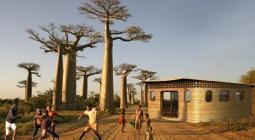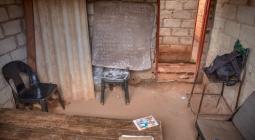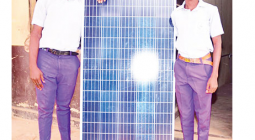Resilient infrastructure gives new hope to students in rural Mozambique.
School offers safe spaces for students to learn
The Sustainable Development Goals (SDGs) are a universal call to action to end poverty, protect the planet and ensure that all people enjoy peace and prosperity by 2030. One of the 17 SDGs aims at ensuring inclusive and equitable quality education, and promoting lifelong learning opportunities for all – this goal is SDG 4. Another goal, SDG 9, aims to build resilient infrastructure, promote inclusive and sustainable industrialization, and foster innovation. In an effort to achieve the SDGs’ educational goals by 2030, special attention should be bestowed upon infrastructure for education, especially infrastructure that can withstand weather changes due to climate change.
A perfect example comes from rural Mozambique, where SDG4 and SDG9 come together; using resilient infrastructure to provide education opportunities for students.
UNCDF with the technical and financial support from the Swedish International Development Agency (SIDA), the Government of Mozambique represented by the Ministry of Economy and Finance through the Provincial Directorate of Economy and Finances, and in collaboration with the Provincial Directorate of Environment and Land and Local Government authorities have partnered to create a climate-resilient school in Guijá District that caters to people living in the last mile in Mozambique.
The 19 De Outubro Primary School became ready for admission on February 2nd, 2019. The school was built on the same site where children used to learn in small huts grouped together to serve as classrooms. When heavy unpredictable rains would hit the area, some of these huts would break down or deteriorate, rendering them useless until they were rebuilt only to see the same fate in a couple of months.
Armando Chivoze, 64, a parent of Lorenço – a student at the school, said: “I am very happy about it. I never dreamt of seeing a school like this. Before we used to worry about the strong winds as they would damage the roofs. Now, we know our children are safe.”
The opening of the new school came approximately one month before the arrival of Cyclone Idai in Mozambique. Although this particular area was not affected by the cyclone, concerns among locals – authorities and parents alike – were high. The conversation on climate-resilient infrastructure was reignited.
The Primary School Director, Hilario Muchanga, 50, has been in the educational field for 15 years and working with this particular school for seven years. He explained: “Previously, we had many students who prefer to study indoors at home, others would miss many classes and some would skip curricula because of the of the lack of protection from the weather or overall weather changes.”
Although the school is small in size, teachers here educate a broad spectrum of classes. These include Portuguese, Mathematics, Naturals Sciences, Physical Education, Visual Education, Civic Studies and English. In order for students not to miss curricula, they would have to be able to make it to on school days despite the weather conditions.
The new infrastructure stands strong against weather changes, and includes safe spaces for learning, separate toilets, new facilities, water access and classroom furniture. Furthermore, the school now can enroll more students because the number of staff has risen and the rooms are much more spacious. The school now caters to 77 boys and girls from four surrounding villages, as opposed to the previous figure of 62 students. Also, the number of school staff has increased from three to five.

Celina Chongo, 43, who has three children in this school, added: “The old mud structure would wither away with time and especially when it rains. I have noticed the children study more and spend more time on school grounds. I live 10 -minutes’ walk from the school and I pass by it often. The students are happier now with the tables and seats, which are much more comfortable than sitting on the floor, which was how they learned before.”
Muchango continued: “One of the reasons there is more attendance these days is because of the facilities that enable them to stay, including access to water and toilets – one for the boys and another for girls. Next, we hope to install a solar panel someday.”
The new infrastructure has provided the students with a better place to learn and to socialize, but it also has been of benefit to the parents. Because the children are more likely to stay in school and attend during bad weather, parents have remarked that they have had much more time to concentrate on their local businesses or tend to younger siblings of the students.
Ramon Cervera, the UNCDF Programme Manager in Mozambique, said: “The aim of this project is to create a synergy between SDG concepts that would benefit the local community and support the sustainable development of local government through resilient, climate adaptive infrastructure that can stand the test of time. UNCDF looks for these kinds of solution in rural areas of Mozambique as they are the hardest to reach.”
Considering the fact that Mozambique is an LDC that is historically more susceptible to devastating weather changes than others, it is essential to protect the most vulnerable and rural areas on the country. As a part of UNCDF’s effort to support local governments with climate adaptation, the organization, along with its partners, have also supported the rehabilitation of clinic in the area and the building of a local market.
Because of the facilities it provides and the space it offers, the school has turned into somewhat of a community center where both students and parents congregate to learn and meet other parents. According to one parent, sometimes when the weather is stormy, their children prefer staying at the school rather than returning home. This is both a testament to the importance of the school to the local community, but also the pressing need for sustainable infrastructure in the area.
The United Nations Capital Development Fund (UNCDF) makes public and private finance work for the poor in the world’s 47 least developed countries. With its capital mandate and instruments, UNCDF offers “last mile” finance models that unlock public and private resources, especially at the domestic level, to reduce poverty and support local economic development.
UNCDF’s financing models work through three channels: inclusive digital economies, connecting individuals, households, and small businesses with financial eco-systems that catalyze participation in the local economy, and provide tools to climb out of poverty and manage financial lives; local development finance, that capacitates localities through fiscal decentralization, innovative municipal finance, and structured project finance to drive local economic expansion and sustainable development; and investment finance, that provides catalytic financial structuring, de-risking, and capital deployment to drive SDG impact and domestic resource mobilization. By strengthening how finance works for poor people at the household, small enterprise, and local infrastructure levels, UNCDF contributes to Sustainable Development Goal-SDG 1 on eradicating poverty and SDG 17 on the means of implementation. By identifying those market segments where innovative financing models can have transformational impact in helping to reach the last mile and address exclusion and inequalities of access, UNCDF contributes to a broad diversity of SDGs.
6 April 2021
UNCDF




